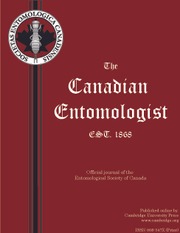Article contents
Sampling Populations of Pine Leaf Adelgid Pineus pinifoliae (Fitch): I. The Gall and Associated Insects1
Published online by Cambridge University Press: 31 May 2012
Abstract
In population studies of the pine leaf adelgid, sampling techniques are required. Procedures for sampling galls on spruce and for associated adelgid stages are described. Gall distributions both within trees and between trees are non-random, following the negative-binomial series. Aggregation within trees arises from a disproportionate number of galls occurring on the upper crown branches. Between trees, gall populations are more dense on the larger trees, and red spruce is more heavily infested where red spruce and black spruce are mixed. The proposed sampling unit is composed of one branch from each of the upper two vertical crown quarters, and one longitudinally halved branch from each of the lower crown quarters. The examination of sample units from 50 trees will provide a reliable estimate of stand populations except where low gall densities or heterogeneous spruce stands make a larger sample mandatory. Additional details of sampling and the biological significance of the findings are discussed.
Information
- Type
- Articles
- Information
- Copyright
- Copyright © Entomological Society of Canada 1965
References
- 7
- Cited by

